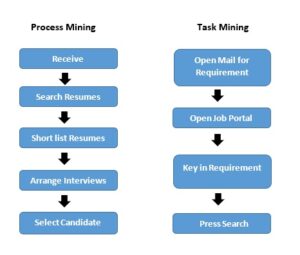
Advance Features
RPA Bots can automate repetitive tasks with speed and accuracy that are unmatched by humans. The efficiency and productivity of businesses and industries can be improved by this Automation Process.
RPA uses intelligent automation technologies to perform repetitive human tasks.
They are:
- Task Mining
- Process Mining
- AI
- Machine Learning
We are going to discuss about Task Mining and Process Mining in this blog.
What is Task Mining?
Task Mining helps the company gain a deep understanding of existing processes handled by the employees, how much work is being done, discover new automation opportunities, and also find process improvement areas.
Businesses are constantly looking for ways to optimize their processes and become more efficient.
But what exactly Task Mining is and how can it be useful and beneficial for businesses?
- Task Mining is an emerging technology that helps companies get a better understanding of how work is being done by employees by monitoring user actions and collecting user interaction data.
- Businesses can observe how the employees handle the work, identify the most common mistakes while performing tasks, and discover tasks that can be automated.
- A Task Mining tool generally monitors what is being done on people’s systems, extracts the needed information, and then analyzes the data to provide meaningful insights.
- Analyze the data and convert it into charts, graphs, heat maps, and process diagrams.
Exemplification
Things like filling in the PO, checking the amounts are correct using tools such as Excel, matching receipts to invoices in Adobe, or spending ten minutes on LinkedIn to research a prospect. Task mining collects and analyzes this data, such as clicks taken, copy/paste, time spent per application, and other details, to reveal how teams execute work and find ways to improve employee experience and productivity.
Examples of Typical Tasks in Task Mining
- Copy-Paste the information
- Uploading or Downloading the documents
- Scrolling through the systems
- Mouse clicks
What can be Achieved?
Task mining can analyze the tasks undertaken by the employee or user and determine where they can be simplified and automated.
End Results
Simpler, more effective tasks are undertaken by users.
Goal
Record the employee’s actions with the goal of optimizing or automating parts of a task.
![]() Benefits of Task Mining
Benefits of Task Mining
Here are the few key benefits of Task Mining,
- Cost Reduction
- Reduces Time spent on Process Documentation.
- Identify Automated Opportunities
- Advance Intelligent Automation
- Standardization
- Process Improvement
- Bring Humans into the Loop
- Turn Ideas into Improvements
What is Process Mining?
Process Mining is a widely used technology to model, analyze, and optimize business processes. Process mining focuses on end-to-end process optimization, such as the overall procurement process.
That transforms data from the system into visual, interactive dashboards. The company can see the existing value decreases, bottlenecks, and discrepancies as well as understand the root causes and possible risks.
Following four steps can be followed to identify how and what can be optimized
- Process Discovery – Identifying as-is processes and identifying process deviations.
- Process Analysis – Identifying the Root Causes For example, businesses can identify homogenous errors by identify the root causes. Through process analysis, we can identify errors and also classify why and where they occur. And we can try to solve them effectively.
- Process Validation – It helps companies validate their process findings and confirm their current situation.
- Process Improvement – Performance Monitoring means process improvement can continuously be identified, monitored, analyzed and solved bottlenecks, challenges, and opportunities in business processes. This helps identify areas where the process can be improved.
- You can use the data from your business applications to gain a detailed understanding of complex business processes.
- Process Mining is a technique to find ways to analyze and optimize business Processes.
- Analyze the digital footprint of processes across all systems, including SAP, Salesforce, ServiceNow etc.
Exemplification
A good example of using process mining is a new customer onboarding. This involves multiple steps, teams across the organization, and various outputs, all of which must happen before transactions can be done with the customer. It could involve checking documentation, credit forms, risk assessment forms, raising a request, the approval or rejection process, and appointment letter generation.
What can be Achieved (Outcomes)?
Process mining can understand the flow of processes and can help improve the flow with automation.
Many organizations gained vital insights into their businesses. Process mining helps companies analyze and improve their existing business processes. In conclusion, companies can achieve various results from process improvement.
End Results
More efficient, automated end-to-end processes.
Goal
Measure’s performance metrics in processes to understand how a process is managed.
![]() Benefits of Process Mining
Benefits of Process Mining
Here are the few key benefits of Process Mining,
- Removes the Risk of Human Error
- Faster and More Accurate
- True end-to-end Understanding of Processes
- Speed up and Improve your Processes
- Reduce Cost
- Improve Customer Satisfaction
- Continuous Improvement
- Identification of Bottlenecks
- Reduce Lead Time

Author
Gayathri Kothapalli
Business Analyst
k.gayathri@vsmsoftware.com
Also Read: Robotic Process Automation (RPA) in Pharma Sales and Marketing.